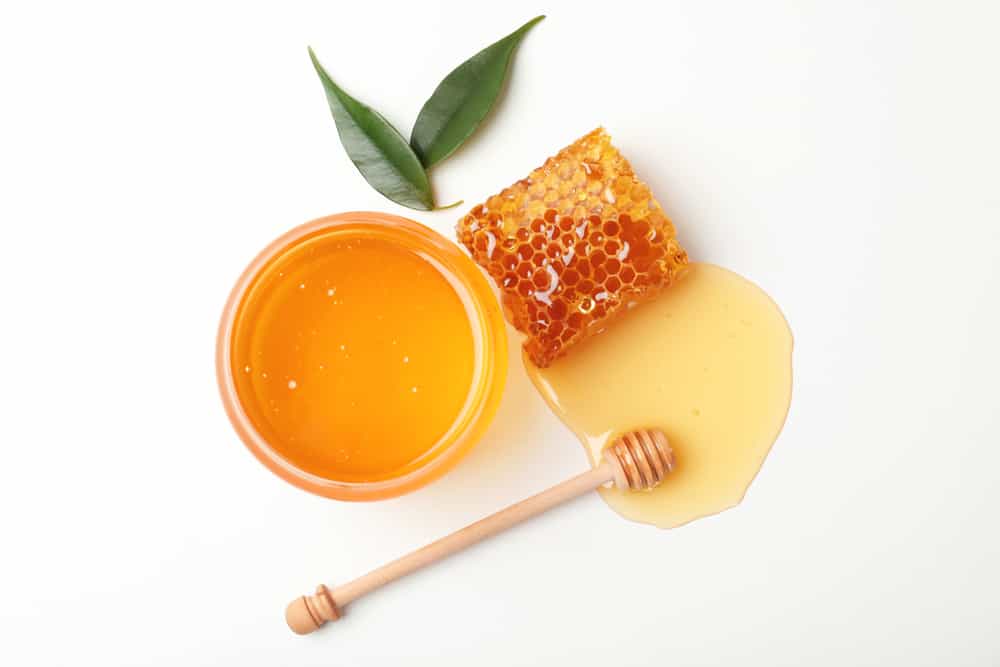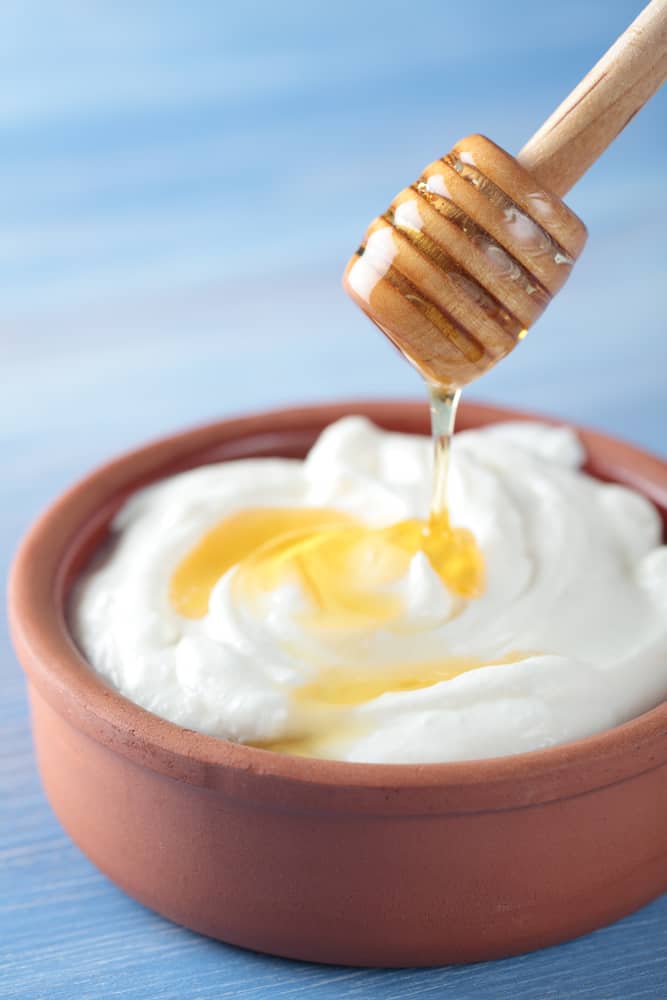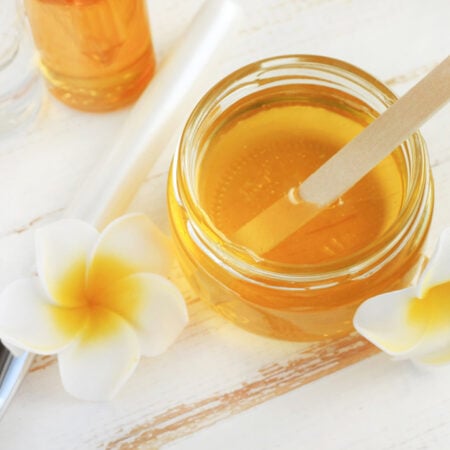As we get older, we often begin to pay more attention to our skincare routines. We want to make sure we’re doing the best we can to prevent blemishes as well as to stave off the effects of aging. Unfortunately, all of the cleansers, exfoliators, serums, masks, sunscreens, and other products we apply to our faces really add up in cost.
Not only that, but ingredient lists are pretty confusing. Pair that with the overwhelming amount of often conflicting information available online, and it feels impossible to pick the right ingredients for your skincare regimen.
Whether you’re interested in a completely natural skincare routine or just want something more affordable, we know of a fantastic skincare option that you likely already have at home: honey! This product is great for your skin, easy to find, and inexpensive (it’s delicious, too). It may just be the solution to your skincare problems.
The Benefits of Honey for Your Skin
You may have already heard that honey is good for your skin, but you may not know why (or maybe you do, and that’s why you’re looking for honey masks). If so, you aren’t the only one. We all know vegetables are good for us, but most of us haven’t spent hours researching their benefits; we just eat them.
That said, once you know all the things honey can do, it might become the next holy grail ingredient that you incorporate into your skincare routine.
First of all, honey has antimicrobial properties. This means it can kill microorganisms like bacteria and fungi on the skin. Not only that, it has wound-healing properties and can be used to treat burns, pityriasis, tinea, seborrhea, dandruff, diaper dermatitis, psoriasis, hemorrhoids, and anal fissures.
While all of this is impressive, we’re a bit more concerned about what it can do for the skin on our faces. Well, honey is an emollient, meaning it moisturizes the skin. Not only that, but it’s also a humectant, meaning it helps the skin retain its moisture. Best of all, it has anti-aging effects that can slow the progression of wrinkles.
If that’s not enough to send you running to your pantry to slather some honey on your face, it has also been found effective for treating rosacea. Even more impressive, honey has anti-carcinogenic qualities and may even be beneficial to those suffering from skin cancer.
5 Easy DIY Honey Masks
After learning about the numerous benefits of honey, you’re probably ready to get mixing a mask. For each mask, we have provided ingredient measurements, but you can adjust the measurements depending on how much you want to make.
Because many of the masks use fresh ingredients, they can’t be made in bulk as some ingredients may spoil after a few days. However, we understand that you may like to use these DIY masks on your neck and hands as well as your face, in which case you may need to make more.

Luckily, these recipes can truly be eyeballed. You just need to make enough to cover the parts of your body you’re looking to treat, and that’s it.
1. Just Honey
Because honey has so many benefits on its own, you can definitely use it as a mask just by itself. A tablespoon or less should be enough to cover your whole face, but you can (and should) also use it on other areas like your neck. Let it sit for 15 minutes before rinsing.
We also recommend using it on your hands if you can live without them for a bit. Your hands are often neglected when it comes to skincare, despite the fact that they are constantly being used and abused. If 15 minutes is too long, try five—your hands deserve all the lovely benefits that honey has to offer!
When time is up, simply rinse the honey off and you’re good to go. You can apply a moisturizer if you have especially dry skin, but it may not be necessary since honey is an emollient.
2. Honey and Avocado
There is evidence that avocado can soothe skin conditions, prevent skin damage, improve skin elasticity, minimize breakouts, prevent dry skin, and improve overall skin health. This makes it a fantastic ingredient for your skincare routine.
Here’s what you’ll need:
- 1 tablespoon of honey
- 1/4 of an avocado
Optional ingredients:
- 1 tablespoon of your favorite oil (jojoba or coconut are great)
- 2 teaspoons of finely ground almonds (if you’re looking to exfoliate)
As you can guess, all you need to do is mix your ingredients together in a bowl until they’re well combined, and then apply to your face. Let the mask sit for about 15 minutes before rinsing or wiping it off with a cloth.
3. Honey and Yogurt
A study published in 2011 found that yogurt can moisturize, brighten, and help retain elasticity in the skin. A separate study from 2015 adds to these benefits, with its results suggesting that yogurt can even out skin tone, protect from UV rays, reduce fine lines and wrinkles, and treat acne.

We love that yogurt can brighten the skin because it makes a great replacement for lemon juice, which is phototoxic. This means that lemon juice (and essential oil) leaves your skin especially sensitive to the sun, greatly increasing your chances of getting burned.
The benefits of yogurt actually come from the probiotics within it. As such, you could use just about any yogurt on your face. However, plain yogurt is typically the best choice because you won’t have to spend any time on Google researching how the other ingredients in flavored yogurts might affect your skin.
Here’s what you’ll need for a yogurt and honey face mask:
- 1 tablespoon of honey
- 1 tablespoon of yogurt
Optional ingredients:
- 1/2 teaspoon of turmeric (great for oily skin or inflammation)
Mix your ingredients together in a bowl and apply the mask to your face. Let it sit for 15 minutes before rinsing with warm water.
4. Honey and Oil
There are a number of oils that are good for the skin. Olive oil is moisturizing, rich in vitamins and antioxidants, and even fights bacteria. Jojoba oil is even better; it’s an antibacterial, an antioxidant, a humectant, hypoallergenic, and non-comedogenic (it won’t clog pores).
While more research still needs to be done, it is also believed that jojoba oil may regulate sebum production, promote collagen, stimulate wound healing, soothe skin conditions like eczema and sunburns, treat acne, reduce the appearance of wrinkles, and minimize the appearance of scars.
Coconut oil is another great choice. It may reduce inflammation, treat acne, and promote wound healing, and also has antimicrobial and moisturizing properties. However, some people do find that coconut oil clogs their pores and exacerbates issues like oily skin.
Here’s how to make a honey and oil mask:
- 1 tablespoon of honey
- 1 tablespoon of your favorite oil
Mix these together until they’re completely combined. Apply it to your face and let it sit for 15 minutes before washing it off with water.
5. Honey and Aloe Vera
We all know that aloe vera is great for treating sunburn. However, it also provides a slew of other benefits to our skin. It contains antioxidants, vitamins, enzymes, and has anti-inflammatory properties. This makes it good at treating acne, burns, and dry skin.
It’s a gentle exfoliator and a moisturizer, although it can dry out your skin if you use too much. Best of all, aloe vera can prevent wrinkles and fine lines (though unfortunately, it cannot undo them).
Here’s what you need for a honey and aloe vera face mask:
- 1 tablespoon of honey
- 1 tablespoon of aloe vera gel (use 2 tablespoons if you want the mixture to be less sticky)
You want to use the purest aloe vera you can find. When shopping, check labels for the percentage of aloe vera in the product and choose the highest one.
Mix the honey and aloe vera together until combined and apply it to your face. Let it sit for 15 minutes before rinsing with warm water.
Affordable Skincare in Your Cupboard
Honey is an amazing skincare ingredient with a multitude of benefits. It’s moisturizing, antimicrobial, anti-aging, anti-carcinogenic, and even helps with a number of skin issues like psoriasis.
It makes for a great face mask on its own, but adding other ingredients means even more benefits for your skin. The best part is, honey is inexpensive, and many of the natural ingredients you can add to your honey mask are as well. You may already have most of them in your cupboard.
